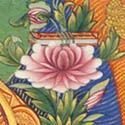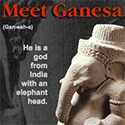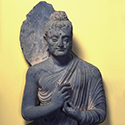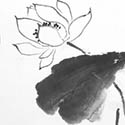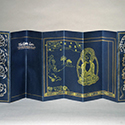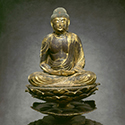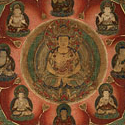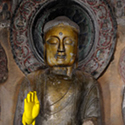|
|
| Show All 80 Results (Text Only) |
|
| A Guide to Decoding Buddhist Symbols in Tibetan Art |
|
| Asia Society
|
“Buddhist thangka paintings are visually captivating and impressive — but there is more to them than meets the eye. Thangkas often focus on a specific deity and scene, and their form and surrounding details are often rich with symbolism, turning them into a medium for religious storytelling. Because of this, extracting all the intricacies and meanings from the paintings requires training.” Site has visuals of symbols with annotation on their meaning.
Go to Museum Resource: https://asiasociety.org/new-york/guide-decoding-buddhist-symbolism-tibetan-art | |
|
|
| How does Art Tell Stories? |
|
| Seattle Art Museum
|
Game about gods from India and Southeast Asia. See Ganesa dance, and discover why Vishnu changes into a boar and Buddha has a bump on his head. After learning about gods from India and Southeast Asia, use this guide for discussing the sculpture, Hinduism, Buddhism and for leading related activities. The unit theme links visual art with language arts, and in some activities with performing arts. Questions and discussion ideas, classroom activities, stories, glossary, and other resources are included. (Activities on Buddha, Vishnu, Hinduism and Buddhism.)
Go to Museum Resource: http://www1.seattleartmuseum.org/onlineActivities/ArtStories/ | |
|
|
| How to Identify a Buddha |
|
| Asian Art Museum of San Francisco
|
"The earliest surviving representations of the Buddha date from hundreds of years after his death, so they are not portraits in the usual sense. Buddha images vary greatly from place to place and period to period, but they almost always show these conventional features..." Downloads includes student handouts and a teacher packet on Hindu Buddhist Art. See also An Introduction to Buddhism.
Go to Museum Resource: https://education.asianart.org/resources/how-to-identify-a-buddha/ | |
|
|
| How to Paint a Lotus |
|
| Asian Art Museum of San Francisco
|
The lotus flower is a Buddhist symbol of purity. Students will learn how to paint a lotus flower using Chinese brushpainting techniques in this hands on activity. Downloads include a lesson plan, teacher packets, visual instructions for the activity, and other resources.
Go to Museum Resource: https://education.asianart.org/resources/how-to-paint-a-lotus/ | |
|
|
| Illuminated Manuscripts: The Sacred Art of Narration |
|
| Asian Art Museum of San Francisco
|
Students will: 1.) Identify the format and elements of a sutra. 2.) Examine why sutras (the teachings of the Buddha) are important historical and religious documents. 3.) Analyze why the writing of sutras is considered an important religious act. 4.) Construct and illustrate an accordion book manuscript based on the sutra format used during the Goryeo dynasty. Downloads include Visual Guides, a Lesson Plan, and Teachers Packet.
Go to Museum Resource: https://education.asianart.org/resources/illuminated-manuscripts-the-sacred-art... | |
|
|
| An Introduction to Japanese Buddhism |
|
| Asian Art Museum of San Francisco
|
Buddhism was officially transmitted to Japan in 525, when the monarch of the Korean kingdom of Baekje sent a mission to Japan with gifts, including an image of the Buddha, several ritual objects, and sacred texts. Buddhism’s journey from India to China, Korea, and Japan had taken about a thousand years. See also An Introduction to Japanese Buddhism video with Professor Robert Sharf, University of California, Berkeley, discusses Japanese Buddhism at the Medieval Japan Teacher Institute at the Asian Art Museum.
Go to Museum Resource: https://education.asianart.org/resources/an-introduction-to-buddhism-in-japan/ | |
|
|
|
| A Journey to Xiangtangshan |
|
| National Museum of Asian Art, Smithsonian Institution
|
Carved into the mountains of northern China, the Buddhist cave temples of Xiangtangshan ("Shahng-tahng-shahn") were the crowning cultural achievement of the Northern Qi ("Chee") dynasty (550-77). The name Xiangtangshan translates to "Mountain of Echoing Halls." It refers to two groups of caves: northern Xiangtangshan and southern Xiangtangshan, located about nine miles apart in Hebei province. Commissioned by devout Buddhist emperors and courtiers, the manmade caves represent the power and prestige of the throne and an eternal appeal for divine protection. They also reflect a long tradition, begun in India, of situating holy places within the earth's mantle.
Go to Museum Resource: https://archive.asia.si.edu/explore/china/xiangtangshan/ | |
|
|
|
| Show All 80 Results (Text Only) |
